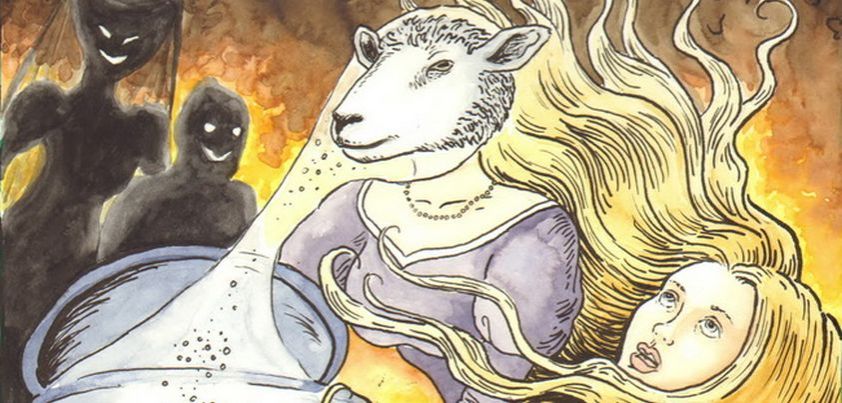 What’s this? A folktale where a wicked queen doesn’t come to a terrible end and stepsisters love each other! Where’s the fun in that? A queen is unhappy that her stepdaughter is more beautiful than her own daughter. So, with a little magic, she pops a sheep’s head onto the prettier one’s shoulders. The two girls run away together and of course marry handsome princes. However, I am a bit worried about a possible message from the story, which seems to suggest that it is OK to steal from babies as long as you do it for a good cause.
What’s this? A folktale where a wicked queen doesn’t come to a terrible end and stepsisters love each other! Where’s the fun in that? A queen is unhappy that her stepdaughter is more beautiful than her own daughter. So, with a little magic, she pops a sheep’s head onto the prettier one’s shoulders. The two girls run away together and of course marry handsome princes. However, I am a bit worried about a possible message from the story, which seems to suggest that it is OK to steal from babies as long as you do it for a good cause.
Our source was a children’s book called English Fairy Stories by folktale collector Joseph Jacobs, first published in 1890. According to Jacobs, his source was a folktale of the same name which appeared two years earlier in Longman’s Magazine. The original was contributed by another famous folktale collector of the time, Andrew Lang. Lang attributes the story to an old lady interviewed by Orkney folklorist Duncan Robertson.
Original Text / PDF (1,219 words)
General Comments
In one way, Kate Crackernuts is a “reverse” version of the Brothers Grimm tale Twelve Dancing Princesses. But here it is a prince who goes out to dance all night and a princess who saves him. In the Grimm story the princesses dance all night because they love to. One wonders why a prince would go out and dance all night when it is slowly killing him!
In his notes to the story, Jacobs wrote:
“It (the Longman’s Magazine version) is very corrupt, both girls being called Kate, and I have had largely to rewrite.”
I find it unthinkable that a folktale collector of Lang’s stature would publish a “corrupt” story… particularly since he was also one of the editors of Longman’s Magazine. If not corrupt, the original story is certainly confusing. This (and Jacobs’s subsequent criticism) may be the reason that Lang did not include a version of Kate Crackernuts among the 437 stories contained in the twelve colored “Fairy Books” for which he is best known.
In researching the story, I saw a suggestion on another website that made me stop and think. Could Lang’s version (where the two girls had the same name) indicate that the original folktale is not about two stepsisters, but a single princess with a split personality? If so, rather than being wicked the Queen was simply a concerned mother trying to cure her daughter of a mental disorder that no one knew about at the time.
The trouble with oral traditions is that they are like the children’s game Chinese Whispers: they change ever so slightly with each telling. Perhaps Jacobs, in changing the original so much because he thought it was “corrupt”, unknowingly “corrupted” it himself and destroyed an important piece of Scottish folklore.